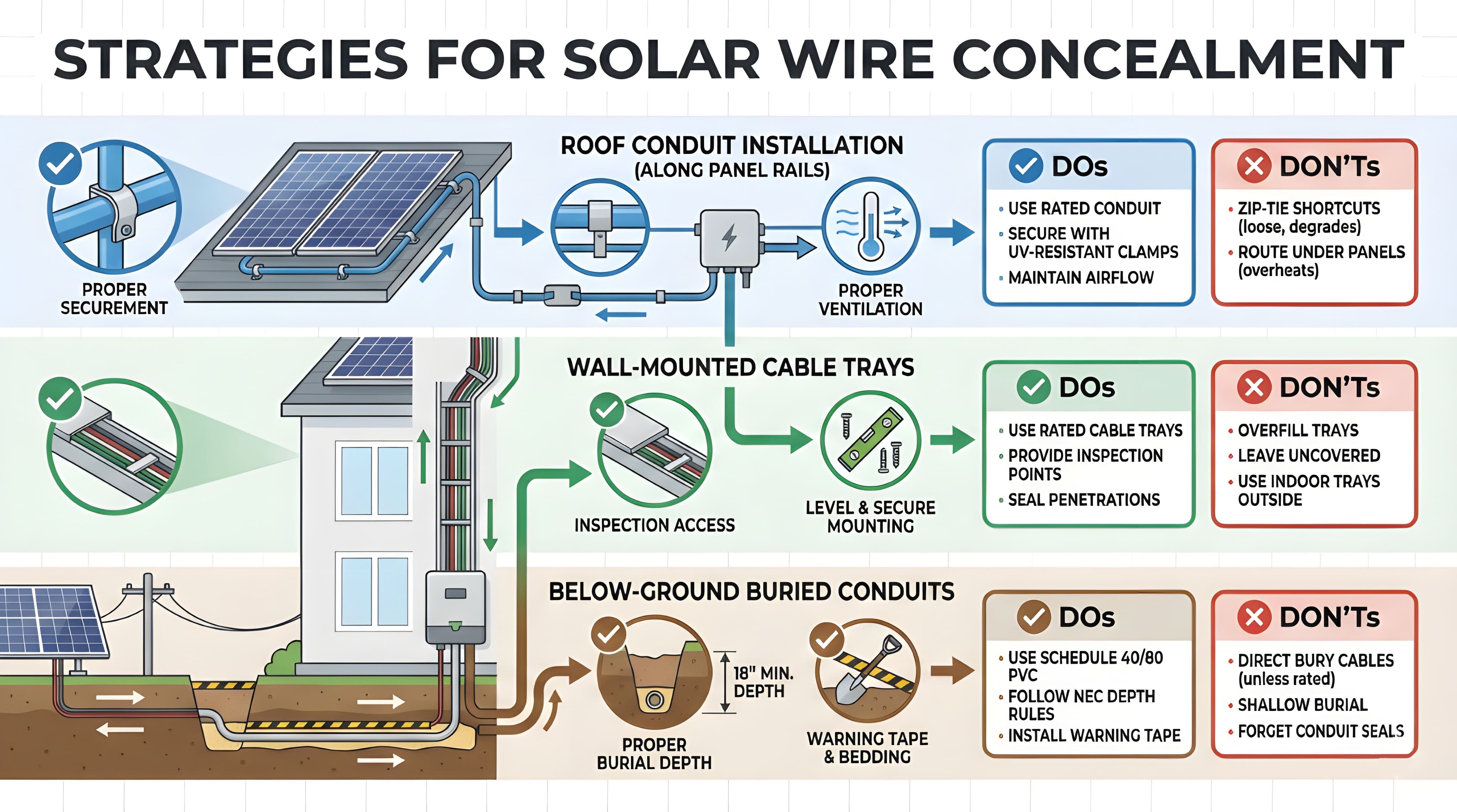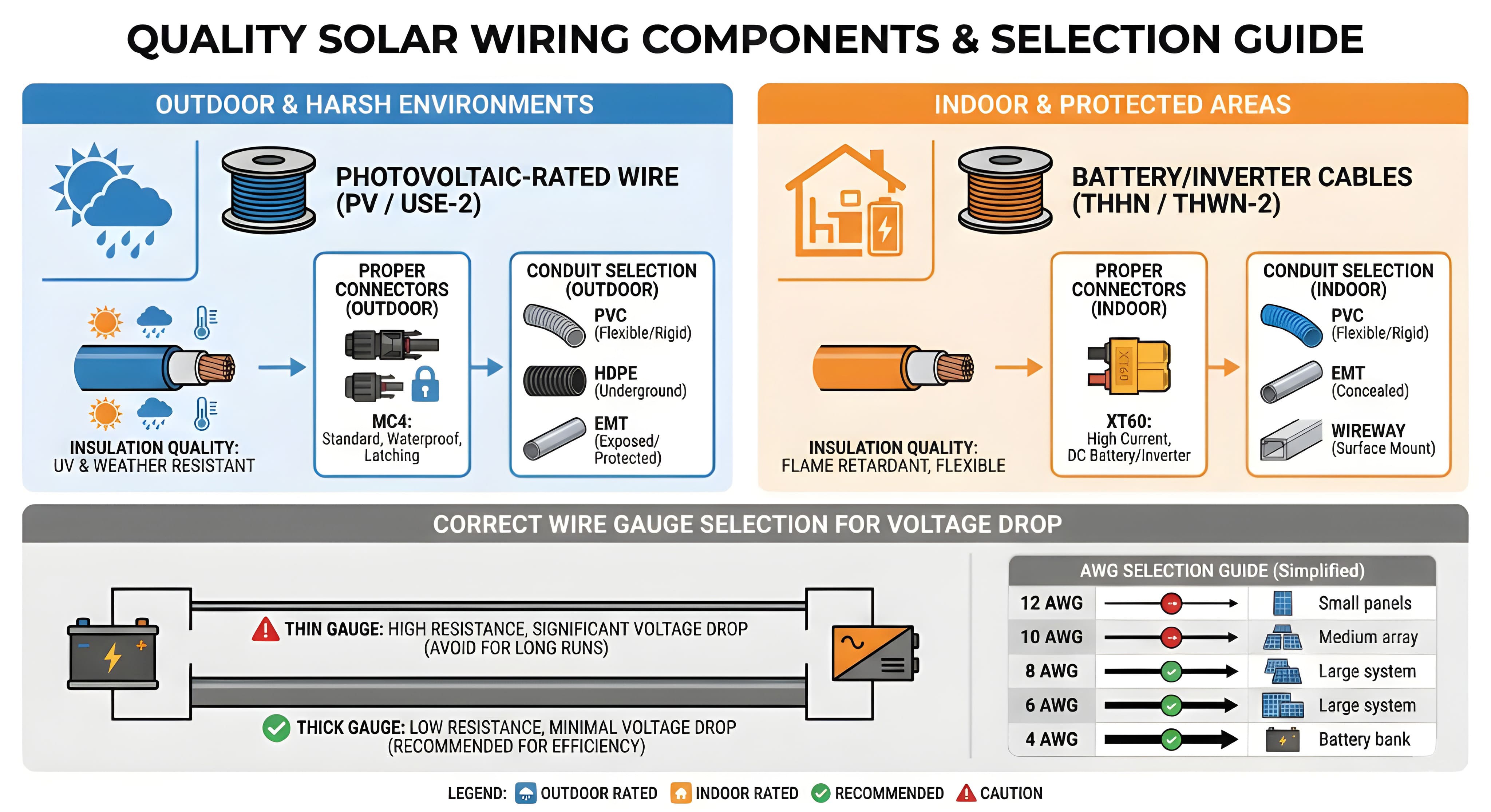

Solar conduit and wire routing plans are essential blueprints that determine how electrical cables travel from solar panels to inverters and batteries. Proper routing plans prevent fire hazards, water damage, and code violations while ensuring long-term system performance. These plans specify conduit types, wire gauges, cable pathways, and protection methods needed for safe solar installations.
A well-designed wire routing plan addresses three critical factors: environmental protection (UV exposure, moisture, temperature extremes), physical security (mounting methods, wildlife barriers, impact resistance), and accessibility (inspection access, maintenance clearances, future expansion). Whether planning a residential solar design or ground-mounted array, routing decisions made during installation directly impact system safety, efficiency, and compliance with National Electrical Code requirements.
Many solar system malfunctions originate from wiring problems. Solar cables carry high voltage across exposed locations like rooftops, building exteriors, or open terrain. Without secure mounting, cables can shift with wind, deteriorate from ultraviolet radiation, or become damaged by wildlife. Sometimes wiring extends into pedestrian areas or play spaces.
Moisture presents another significant challenge. Exterior wiring lacking adequate sealing can trap water, leading to corrosion or electrical shorts. Many assume "outdoor rated" guarantees complete waterproofing. This assumption proves incorrect unless all components, including connectors and junction boxes, meet rigorous sealing standards.
Defective wiring endangers more than equipment. It can invalidate homeowner insurance policies or breach local electrical codes. These consequences should be prevented through proper planning.

Wire concealment serves practical protection purposes beyond visual appeal. However, hiding solar panel cables requires thoughtful planning. Complete enclosure without consideration can create problems. Electrical cables produce heat during operation and require adequate ventilation. Regular inspection access also remains necessary.
Effective concealment methods include:
Roof Conduit Installation: Mount ultraviolet-resistant conduits along roof ridges or beneath panel mounting rails. This approach protects cables while keeping them unobtrusive. Understanding proper conduit installation techniques ensures compliance with building standards.
Wall-Mounted Cable Management: For vertical runs, cable trays or surface raceways provide protection and organization.
Below-Ground Installation: When connecting distant panel arrays, bury cables within rigid conduit rated for outdoor and subsurface use. Always meet local depth requirements, typically 18 to 24 inches.
Avoid securing wires with simple zip ties to gutters or fencing. These shortcuts frequently result in failure.
Even experienced installers occasionally make preventable mistakes. The most common issues include:
Prevention begins with thorough planning and awareness. Always verify compliance with building code standards and manufacturer guidelines. Many installers overlook critical DC connector risks that can lead to system failures.
Not all situations allow for drilling through walls or trenching across lawns. Portable solar systems provide faster, cleaner alternatives, particularly for renters, off-grid applications, or recreational vehicle users.
These systems often feature foldable panels designed for quick deployment. They typically connect using sealed, high-efficiency connectors, with cables stored neatly in integrated compartments. No tools are required, and no wire runs across yards or walls are necessary. Everything remains compact, protected, and transportable.
Many portable units include waterproof ratings, eliminating concerns about rain or dust exposure. Voltage and current specifications pair optimally with portable power stations, minimizing overload or compatibility risks. For those seeking reliable solar power without traditional installation complications, portable configurations offer practical solutions.

Using incorrect wire represents a common beginner error. Solar installations require photovoltaic-rated wire. These cables withstand high voltage and ultraviolet exposure. Standard indoor wire or extension cords are unsuitable.
Key material considerations include:
Cable Type: Select PV wire or USE-2 cable specifications that meet electrical fundamentals standards.
Insulation Quality: Must resist ultraviolet radiation and weather exposure.
Connector Standards: MC4 or XT60 connectors provide industry-standard performance. They create secure seals preventing corrosion.
Conduit Selection: Use non-metallic conduit (PVC or HDPE) for exterior runs, and EMT for interior applications. Detailed wiring and fusing guidelines help ensure proper installation. Industry best practice standards provide additional technical specifications.
Wire gauge selection matters significantly. Longer cable runs require larger wire sizes to minimize voltage drop. Always calculate wire sizing based on total system amperage and distance.
Rooftop installations face additional environmental stress. Temperature extremes, precipitation, wind forces, and wildlife create ongoing challenges. Proper mounting techniques include:
Code compliance remains critical. Follow established electrical planning standards covering grounding, wire spacing, and circuit identification. Even owner-performed installations should meet inspection standards. Understanding three-line diagrams helps visualize proper connections.
Certain aspects of solar installation suit do-it-yourself approaches. Wiring presents greater complexity.
Systems operating below 50 volts without grid connection may allow safe owner installation with proper research and caution. Grid-connected systems or those exceeding 48V DC typically require licensed electrician involvement. Errors in this domain extend beyond power loss to include fire hazards, insurance complications, or personal injury. Reviewing comprehensive solar manuals helps DIY installers understand critical safety requirements.
Understanding wiring design still provides value when working with professional installers. Knowledge enables informed discussions about cable protection, routing options, and concealment strategies. Many commercial solar designs require specialized expertise beyond residential installations.
Consulting residential PV guidelines provides foundational knowledge for system planning.
Quality wiring maintains solar system efficiency, longevity, and safety. Professional installations prevent damage, reduce maintenance requirements, and protect financial investments. Whether using fixed rooftop arrays or portable solar panels, planning wiring layouts with safety and concealment as priorities creates meaningful advantages.
Begin with quality materials. Protect wiring from heat, moisture, and wind. Avoid rushing installation or taking unnecessary risks. When uncertainties arise, consult Solar Permit Solutions professionals. Careful planning prevents expensive future corrections.
Understanding solar interconnection methods helps determine optimal system configuration. For systems requiring supply-side connections, additional planning ensures code compliance.
Proper wiring installation stands as one of the most critical yet underestimated aspects of solar energy systems. The difference between a safe, efficient solar setup and a potential hazard often comes down to cable management, material selection, and adherence to established safety protocols. While panels and inverters capture attention, the wiring infrastructure determines whether the system operates reliably for decades or requires costly repairs within years.
Taking time to plan wire routes, select weather-resistant materials, and implement proper concealment methods pays dividends through enhanced safety, improved system longevity, and reduced maintenance needs. Whether choosing professional installation or tackling suitable projects independently, understanding these principles empowers better decision-making and identifies quality workmanship. Reviewing comprehensive photovoltaic system guides provides additional technical insights.
Solar technology continues advancing, but fundamental wiring principles remain constant. Prioritizing protection from environmental factors, ensuring proper grounding, maintaining code compliance, and planning for future access creates installations that perform optimally while minimizing risks. Working with experienced providers who understand permit processing requirements ensures projects meet all regulatory standards. Learning from detailed solar installation case studies reveals real-world implementation strategies.
These practices transform solar investments from potential liabilities into reliable, long-term energy solutions. For expert guidance on solar design services or assistance navigating installation without permits, professional consultation ensures compliance and safety.
What consequences result from improper solar panel grounding?
Inadequate grounding creates significant safety hazards and long-term system vulnerabilities. Without proper grounding, stray voltages can accumulate, increasing electric shock or fire risk during fault conditions. Systems also become susceptible to lightning strikes or static discharge damage. Most local building codes mandate grounding for both safety and compliance. Include grounding verification in design and inspection procedures.
How can solar wiring be protected from rodent damage?
Rodents such as mice and squirrels frequently chew exposed solar cables. Protect wires with metal conduit or flexible armored cable where feasible. Alternatively, install ultraviolet-resistant wire mesh or pest-resistant conduit. Avoid loose or looped cable sections that attract gnawing. Some manufacturers offer rodent-deterrent cable covers.
Do wireless solar systems eliminate exposed wiring needs?
Wireless power transmission remains impractical for residential solar applications currently, though wireless monitoring systems reduce signal wiring requirements. System performance and status can be tracked remotely through applications. Power transmission still requires physical conductors, but modern systems offer modular plug-and-play configurations simplifying installation.
What approach works best for planning wiring routes before installation?
Survey the property noting panel locations, roof access points, and main electrical panel position. Create a system diagram showing paths from panels to inverters and batteries. Prioritize short, direct runs while avoiding high-traffic zones. Document conduit, mounting clip, and junction box locations. This preparation minimizes installation costs and risks.
How should wiring be managed when panels span multiple building surfaces?
Multi-surface installations require careful coordination. Wire each array as separate strings, connecting them through underground or overhead conduit runs to a central combiner or inverter. Ground and weatherproof all connections. Microinverters can reduce DC wiring complexity between arrays.
We are dedicated to providing top-notch solar permit services to homeowners, business owners, DIY, and solar installers. Contact us today.